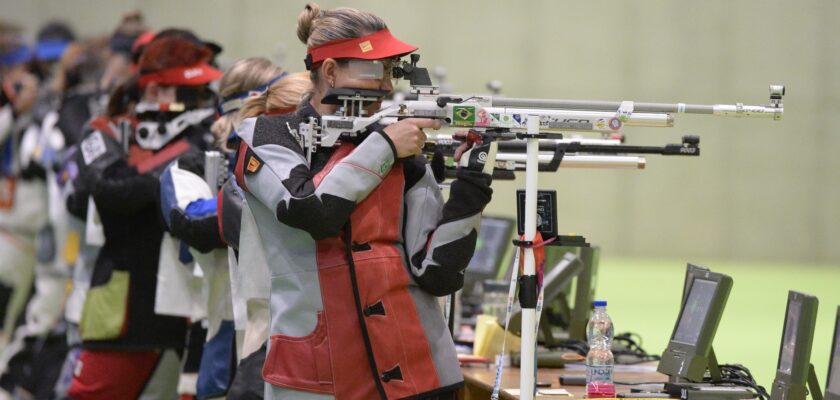Want to know all the rules of Paralympic shooting? In this article, we answer your questions and present the scoring, categories and particularities of this sport adapted for athletes with disabilities.
Paralympic shooting is a sport that combines precision, concentration and technique, offering an inclusive platform for athletes to compete on equal terms.
Rooted in the principles of traditional shooting, this adapted version implements specific rules and detailed classifications to meet the diverse needs of competitors.
Paralympic shooting rules cover everything from the use of adapted equipment and different shooting positions to strict scoring and safety criteria, ensuring an exciting yet safe competition.
Open your Betano account and get up to R$1,000 in bonuses.
PIX payments, live games and super odds!
Click here to open your account!
Paralympic shooting rules: scoring
The scoring system in paralympic shooting is based on the accuracy of the shots in relation to the center of the target – which, in turn, is made up of numbered concentric rings, usually from 1 to 10, with the center of the target (the “10”) being the maximum score. The rings get smaller and smaller as they get closer to the center.
Types of Target
- Air rifle and air pistol: the targets for these disciplines are generally smaller and used at specific distances (10 meters for pistols and air rifles, for example).
- Lying carbine: Larger targets can be used for longer distances (50 meters, for example).
Scoring
Each shot is scored according to its proximity to the center of the target. A shot that hits the center of the target (the “10”) receives the maximum score of 10 points.
Shots that hit the outermost rings receive progressively lower scores, from 9 for the ring immediately outside the center to 1 for the outermost ring.
But in high-level competitions, the score can be measured in tenths to increase the accuracy of the score.
For example: a shot that hits close to the center can be scored as 10.9, while a shot a little further away can be scored as 10.5, and so on. This allows more precise differentiation between shots that are very close together.
Classifications
Competitions consist of a predetermined number of shots. For carbine and air pistol events, there may be 40 or 60 shots in the qualification phase, depending on the specific rules of the competition.
An athlete’s total score is the sum of the scores of all valid shots fired during the qualification or final phase. In finals events, the score can be reset and the shots scored individually to determine the winner.
Basically, the best shooters from the qualification stage advance to the final stage. In the final, shooters compete in additional shooting series and scoring can be more detailed with decimal scoring.
The finals usually have an elimination format, where the athletes with the lowest scores are eliminated in stages, until only the medalists remain.
Progressive Elimination
During the finals, the athletes are eliminated one by one based on the score accumulated in the shooting rounds. The last remaining athlete with the highest score is the winner of the competition.
In short, the total points accumulated over the rounds determines the shooter’s performance, with the top scorers advancing to the final stages and competing for the podium.
Paralympic shooting rules: categories
In Paralympic shooting, athletes can compete in different shooting positions – standing, lying down and kneeling. Each position requires specific techniques to maximize accuracy and control during the competition.
Standing paralympic shooting
In the standing position, the athlete stands and fires the gun towards the target. The position requires good balance and body stability, as any unwanted movement can affect the accuracy of the shot.
Athletes often use armrests or other devices to help with the stability of the weapon. The position is commonly used in air pistol competitions and can vary in distances and number of shots per round, depending on the specific competition.
Paralympic shooting lying down
In the lying position, the athlete lies on the ground or on a suitable surface and shoots. The position offers greater natural stability, as the body is fully supported.
Athletes use gun rests and other devices to ensure a comfortable and stable position. The position is common in recumbent rifle competitions, where athletes compete over longer distances and can fire more shots per round.
Kneeling Paralympic shooting
In the kneeling position, the athlete kneels on the ground or on a suitable surface and shoots. The position offers a good combination of stability and flexibility of movement.
The kneeling position is less common, but can be used in rifle or pistol competitions, depending on the specifications of the event.
Paralympic shooting rules: classes
In Paralympic shooting, athletes are classified based on their disability. This is to ensure fairer conditions for the participants. In any case, the division is made into two classes: SH1 and SH2.
- SH1 Pistol and carbine shooters who do not require support for the weapon.
- SH2 Carbine shooters who do not have the ability to support the weight of the weapon with their arms and need support for the weapon.
Now that you know all the rules of paralympic shooting, how about learning more about this sport? Check out our content and become a true expert on the subject!



